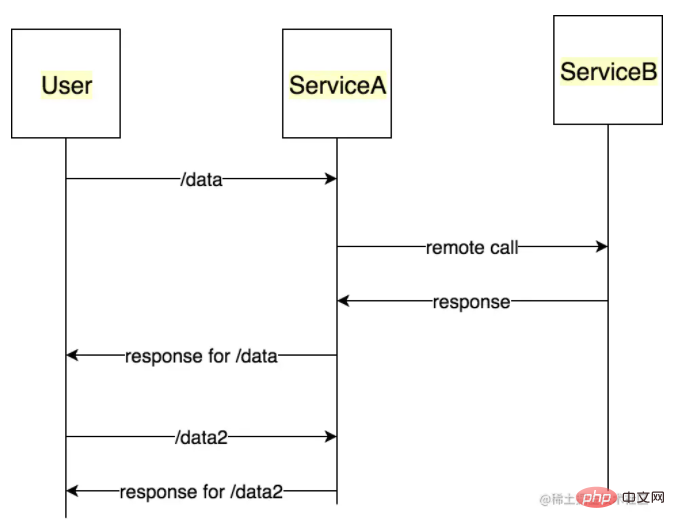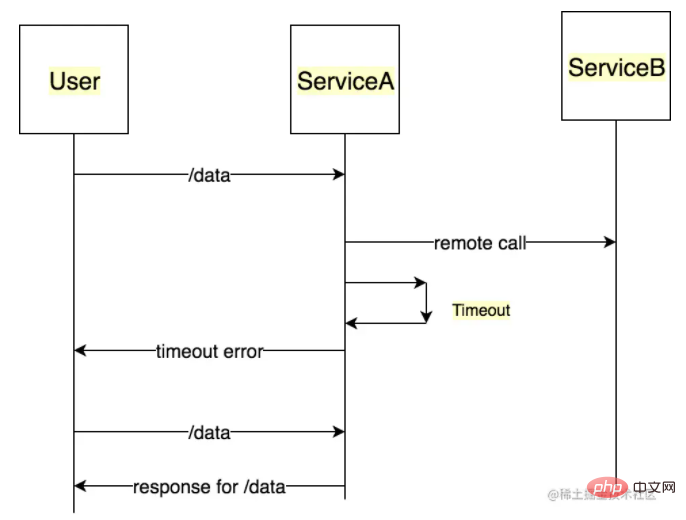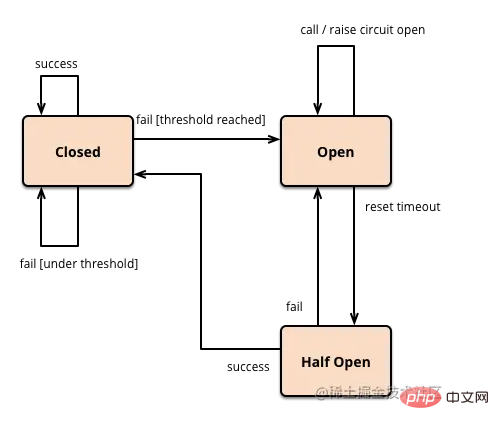Node.js のサーキット ブレーカー メカニズムの詳細な分析
この記事では、Node.js のサーキット ブレーカー メカニズムについて説明します。お役に立てば幸いです。

アーキテクチャの進化による問題
従来の CS アーキテクチャを使用すると、障害などの理由でサーバーがリクエストをブロックし、お客様がクライアントのリクエストは応答を失い、その結果、ユーザーのグループは一定期間後にサービスを取得できなくなります。この状況によって考えられる影響は限定的であり、推定することができます。
ただし、マイクロサービス システムでは、サーバーが他のいくつかのマイクロサービスに依存している可能性があり、これらのマイクロサービスはさらに他のマイクロサービスに依存している可能性があります。この場合、特定のサービスがダウンストリームの輻輳を引き起こす可能性があり、致命的な結果を引き起こす可能性があります。瞬間的 (数秒以内) のカスケード的なリソース消費により、リンク全体が停止します。これを「サービス崩壊」と呼びます。 [推奨される学習: 「nodejs チュートリアル 」]


- #ヒューズモード: 名前が示すように、家庭用回路と同じように、ラインの電圧が高すぎるとヒューズが切れて火災を防ぎます。サーキットブレーカーモードを使用するシステムでは、上流のサービス呼び出しが遅い、またはタイムアウトが多いことが判明した場合、サービス呼び出しは直接終了され、情報が直接返され、リソースが解放されます。素早く。アップストリーム サービスが改善されるまで、通話は再開されません。
- 分離モード: さまざまなリソースまたはサービスへの呼び出しをいくつかの異なるリクエスト プールに分割します。1 つのプール内のリソースが使い果たされても、他のリソースへのリクエストには影響せず、シングル ポイントを防ぎます。障害によりすべてのリソースが消費されます。これは非常に伝統的な災害復旧設計です。
- 電流制限モード: サーキットブレーカーと絶縁はどちらも後処理方法であり、電流制限モードでは問題が発生する前にその可能性を低減できます。電流制限モードでは、特定のサービスのリクエストに対して最大 QPS しきい値を設定でき、しきい値を超えたリクエストは直接返され、処理用のリソースを占有しなくなります。ただし、電流制限モードではサービス崩壊の問題を解決することはできません。サービス崩壊は多くの場合、多数のリクエストによってではなく、複数のカスケード層の増幅によって引き起こされるためです。
- サーキット ブレーカーのメカニズムと実装
サーキット ブレーカーの存在は、保護層を提供することに相当します。サービスとリソースの場合、サーキット ブレーカーはこれらのエラーを監視し、特定のしきい値に達するとリクエストを失敗させることで、リソースの過剰な消費を防ぐことができます。また、サーキットブレーカーはサービスの状態を自動的に認識して復旧する機能も備えており、上流サービスが正常に戻った場合には、サーキットブレーカーが自動的に判断して通常のリクエストを再開することができます。
サーキット ブレーカーを使用しないリクエスト プロセスを見てみましょう: ユーザーは ServiceA に依存してサービスを提供し、ServiceA は ServiceB によって提供されるサービスに依存します。この時点で ServiceB が失敗すると仮定します。10 分以内、リクエストごとに、応答に 10 秒の遅延が発生します。
 つまり、N 人のユーザーが ServiceA のサービスをリクエストしているとします。ServiceB へのリクエストが一時停止されるため、数秒以内に ServiceA のリソースが消費されます。ユーザーからのその後のリクエストを拒否します。ユーザーにとって、これは ServiceA と ServiceB の両方が同時に失敗し、サービス リンク全体が崩壊したことを意味します。
つまり、N 人のユーザーが ServiceA のサービスをリクエストしているとします。ServiceB へのリクエストが一時停止されるため、数秒以内に ServiceA のリソースが消費されます。ユーザーからのその後のリクエストを拒否します。ユーザーにとって、これは ServiceA と ServiceB の両方が同時に失敗し、サービス リンク全体が崩壊したことを意味します。
そして、ServiceA にサーキット ブレーカーを設置するとどうなるでしょうか?
- 障害の数が特定のしきい値に達すると、サーキット ブレーカーは ServiceB へのリクエストが無効であると判断します。この時点では、ServiceA は ServiceB をリクエストし続ける必要はありませんが、直接失敗を返すか、他のフォールバックからのバックアップ データを使用します。この時点で、サーキットブレーカーは
- 開回路
状態になります。
一定の時間が経過すると、サーキット ブレーカーは ServiceB が復旧したかどうかを定期的に問い合わせ始めます。この時点では、サーキット ブレーカーは - 半開##になっています。 # 州。
ServiceB が復旧すると、サーキット ブレーカーは
closed - 状態になり、このとき ServiceA は通常どおり ServiceB を呼び出し、結果を返します。
サーキットブレーカーのステータス図は次のとおりです。 
次のことが考えられます。いくつかの核心点は次のとおりです: 
- 失敗のしきい値: つまり、サーキット ブレーカーが開回路をトリガーします。以前は、必要な障害の数
- #再試行タイムアウト: サーキット ブレーカーが開回路状態にある場合、要求を再試行する、つまり半開状態に入るまでにどのくらいの時間がかかりますか
class CircuitBreaker {
constructor(timeout, failureThreshold, retryTimePeriod) {
// We start in a closed state hoping that everything is fine
this.state = 'CLOSED';
// Number of failures we receive from the depended service before we change the state to 'OPEN'
this.failureThreshold = failureThreshold;
// Timeout for the API request.
this.timeout = timeout;
// Time period after which a fresh request be made to the dependent
// service to check if service is up.
this.retryTimePeriod = retryTimePeriod;
this.lastFailureTime = null;
this.failureCount = 0;
}
}async call(urlToCall) {
// Determine the current state of the circuit.
this.setState();
switch (this.state) {
case 'OPEN':
// return cached response if no the circuit is in OPEN state
return { data: 'this is stale response' };
// Make the API request if the circuit is not OPEN
case 'HALF-OPEN':
case 'CLOSED':
try {
const response = await axios({
url: urlToCall,
timeout: this.timeout,
method: 'get',
});
// Yay!! the API responded fine. Lets reset everything.
this.reset();
return response;
} catch (err) {
// Uh-oh!! the call still failed. Lets update that in our records.
this.recordFailure();
throw new Error(err);
}
default:
console.log('This state should never be reached');
return 'unexpected state in the state machine';
}
}// reset all the parameters to the initial state when circuit is initialized
reset() {
this.failureCount = 0;
this.lastFailureTime = null;
this.state = 'CLOSED';
}
// Set the current state of our circuit breaker.
setState() {
if (this.failureCount > this.failureThreshold) {
if ((Date.now() - this.lastFailureTime) > this.retryTimePeriod) {
this.state = 'HALF-OPEN';
} else {
this.state = 'OPEN';
}
} else {
this.state = 'CLOSED';
}
}
recordFailure() {
this.failureCount += 1;
this.lastFailureTime = Date.now();
}... const circuitBreaker = new CircuitBreaker(3000, 5, 2000); const response = await circuitBreaker.call('http://0.0.0.0:8000/flakycall');
Opossum## と呼ばれる昔に作成された # 成熟した Node.js サーキット ブレーカー実装。リンクはここにあります: Opossum。分散システムの場合、このライブラリを使用すると、サービスの耐障害性が大幅に向上し、サービス障害の問題を根本的に解決できます。
元のアドレス: https://juejin.cn/post/7019217344601948173プログラミングビデオ著者: ES2049 / Singularity を探しています
プログラミング関連の知識をさらに増やす 、
以上がNode.js のサーキット ブレーカー メカニズムの詳細な分析の詳細内容です。詳細については、PHP 中国語 Web サイトの他の関連記事を参照してください。

ホットAIツール

Undresser.AI Undress
リアルなヌード写真を作成する AI 搭載アプリ

AI Clothes Remover
写真から衣服を削除するオンライン AI ツール。

Undress AI Tool
脱衣画像を無料で

Clothoff.io
AI衣類リムーバー

AI Hentai Generator
AIヘンタイを無料で生成します。

人気の記事

ホットツール

メモ帳++7.3.1
使いやすく無料のコードエディター

SublimeText3 中国語版
中国語版、とても使いやすい

ゼンドスタジオ 13.0.1
強力な PHP 統合開発環境

ドリームウィーバー CS6
ビジュアル Web 開発ツール

SublimeText3 Mac版
神レベルのコード編集ソフト(SublimeText3)

ホットトピック
 7463
7463
 15
15
 1376
1376
 52
52
 77
77
 11
11
 18
18
 17
17
 Nodeのメモリ制御に関する記事
Apr 26, 2023 pm 05:37 PM
Nodeのメモリ制御に関する記事
Apr 26, 2023 pm 05:37 PM
ノンブロッキングおよびイベント駆動に基づいて構築されたノード サービスには、メモリ消費量が少ないという利点があり、大量のネットワーク リクエストの処理に非常に適しています。大量のリクエストを前提として、「メモリ制御」に関する問題を考慮する必要があります。 1. V8 のガベージ コレクション メカニズムとメモリ制限 Js はガベージ コレクション マシンによって制御されます
 Node V8 エンジンのメモリと GC の詳細な図による説明
Mar 29, 2023 pm 06:02 PM
Node V8 エンジンのメモリと GC の詳細な図による説明
Mar 29, 2023 pm 06:02 PM
この記事では、NodeJS V8 エンジンのメモリとガベージ コレクター (GC) について詳しく説明します。
 Node の File モジュールについて詳しく説明しましょう
Apr 24, 2023 pm 05:49 PM
Node の File モジュールについて詳しく説明しましょう
Apr 24, 2023 pm 05:49 PM
ファイル モジュールは、ファイルの読み取り/書き込み/開く/閉じる/削除の追加など、基礎となるファイル操作をカプセル化したものです。ファイル モジュールの最大の特徴は、すべてのメソッドが **同期** と ** の 2 つのバージョンを提供することです。 asynchronous**、sync サフィックスが付いているメソッドはすべて同期メソッドであり、持たないメソッドはすべて異種メソッドです。
 最適な Node.js Docker イメージを選択する方法について話しましょう。
Dec 13, 2022 pm 08:00 PM
最適な Node.js Docker イメージを選択する方法について話しましょう。
Dec 13, 2022 pm 08:00 PM
ノード用の Docker イメージの選択は些細なことのように思えるかもしれませんが、イメージのサイズと潜在的な脆弱性は、CI/CD プロセスとセキュリティに大きな影響を与える可能性があります。では、最適な Node.js Docker イメージを選択するにはどうすればよいでしょうか?
 Node.js 19 が正式リリースされました。その 6 つの主要な機能についてお話しましょう。
Nov 16, 2022 pm 08:34 PM
Node.js 19 が正式リリースされました。その 6 つの主要な機能についてお話しましょう。
Nov 16, 2022 pm 08:34 PM
Node 19 が正式リリースされましたので、この記事では Node.js 19 の 6 つの主要な機能について詳しく説明します。
 Node.js の GC (ガベージ コレクション) メカニズムについて話しましょう
Nov 29, 2022 pm 08:44 PM
Node.js の GC (ガベージ コレクション) メカニズムについて話しましょう
Nov 29, 2022 pm 08:44 PM
Node.js はどのように GC (ガベージ コレクション) を行うのでしょうか?次の記事で詳しく説明します。
 ノードがnpmコマンドを使用できない場合はどうすればよいですか?
Feb 08, 2023 am 10:09 AM
ノードがnpmコマンドを使用できない場合はどうすればよいですか?
Feb 08, 2023 am 10:09 AM
ノードが npm コマンドを使用できない理由は、環境変数が正しく設定されていないためです。解決策は次のとおりです: 1. 「システムのプロパティ」を開きます; 2. 「環境変数」->「システム変数」を見つけて、環境を編集します。変数; 3.nodejs フォルダーの場所を見つけます; 4.「OK」をクリックします。
 Nodeのイベントループについて話しましょう
Apr 11, 2023 pm 07:08 PM
Nodeのイベントループについて話しましょう
Apr 11, 2023 pm 07:08 PM
イベント ループは Node.js の基本的な部分であり、メイン スレッドがブロックされていないことを確認することで非同期プログラミングが可能になります。イベント ループを理解することは、効率的なアプリケーションを構築するために重要です。次の記事では、Node のイベント ループについて詳しく説明します。お役に立てれば幸いです。




